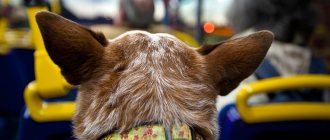The situations in which passengers take pets on the road vary. There are a large number of transportation of livestock, therefore, at the level of regulations of the state body of the Russian Federation, requirements for the transit of pets in vehicles, including bus transport, have been approved.
With routes between suburbs and cities, there are practically no problems with transporting domestic animals. There are many difficulties with traveling on intercity transport. A passenger with a pet is often not allowed into the cabin of a long-distance bus. Who is right in this situation: the person who bought the ticket, or the driver who is worried about his bus and the convenience of other passengers? There are legal laws that clarify the true state of affairs.
According to the decree, transportation of livestock is possible only within the state.
Carrying pets on international bus routes has been prohibited since 2014. When friends tell you that they traveled without problems with a cat or dog on a bus, find out in what year and where the trip took place.
According to clause 2.2 of the Rules for the use of intercity buses, the following animals can be transported in carriers with a solid base:
- birds;
- small breed dogs;
- cats;
- hamsters
Clause 2.3 of the Rules for the Transportation of Large Dogs refers to hunting or service breeds. Dogs are transported in accordance with transportation instructions. The dog must appear before the controller:
- with a shortened leash;
- with a protective device placed on the muzzle;
- with a document confirming the presence of a rabies injection;
- in its purest form.
Large dogs are transported only on the platform at the end of the cabin and are kept near the owner. Therefore, the ticket is purchased for seats at the end of the bus.
There is always a human factor and the owner of the vehicle may refuse to let you in with a dog or cat. The carrier defends personal interests, although there is a single law. Whether you go with this driver depends on your legal knowledge and willingness to defend your rights.
There will be no disputes when you consult about traveling with your pet when purchasing a long-distance bus ticket. Find out the main points of transportation from the intended carrier. If you receive a refusal, then dispute the situation in advance or look for another way to travel.
Rules for transporting dogs by bus
All owners of animals, especially dogs, are always concerned with the question: “Is it possible to transport it on a bus?” For an answer to this question, we turned to the director of a commercial bus company (adc-tour.ru).
Transporting dogs is allowed throughout the country, but since 2014 it is not allowed to do so on international buses. It is allowed to carry small animals (cats, mini dogs) and birds in a special cage or carrier without additional charge, but for other animals, including dogs, you need to pay for baggage or buy a child or adult ticket.
The conditions for transporting animals in land and passenger transport in Russia are determined in accordance with the rules for using a particular type of transport. Regarding buses, these are the rules of use:
- BY CITY BUSES,
- SUBURBAN COMMUNICATIONS,
- INTERCITY COMMUNICATIONS.
Before your trip, we recommend that you print out a copy of the rules from the Ministry of Transport website, since practice has shown that not all cashiers and conductors know the all-Russian rules. Remember, the carrier cannot have its OWN RULES - refusal to transport a dog is a direct violation of the law, but only if you have all the necessary documents and have not violated the rules yourself. Renting a bus to a vacation spot or corporate event also falls under these rules, and you cannot be denied a trip with your beloved dog to our south. But we would still recommend notifying the carrier about the four-legged passenger in advance and, depending on his reaction, prepare.
A mandatory condition for large dogs is a muzzle and a leash. But the law clearly states that the dog must not disturb other passengers, so even for a pug it is better to purchase a muzzle to protect itself from the “evil conductor.” When a group of dog lovers travels on a bus, a separate seat must be purchased for each pet. For a large dog, it is necessary to have such a place; the pet must also be limited in movements, i.e. do not walk around the salon.
There are cases when they refuse to board because the law only says about transporting service and hunting dogs, but you are not required to present any documents about the breed, so such a refusal to board is not legal. Moreover, further in the text it is said that such dogs (meaning large ones) are transported in the rear seats (platforms) of the bus. But if there is no such place, then a large dog may be refused, and for good reason. Therefore, immediately at the box office, inquire about the presence of a back area. In practice, cashiers or conductors sell tickets for the seats with the widest aisle, and many allow you to sit on a seat with a cushion. But all this is a human factor, so never be rude to the driver or conductor, just protect the rights of your dog.
Tip: For transporting small animals, it is best to use a specialized container or bag. Due to the fact that their walls are usually covered with holes, they are quite comfortable for the animal to stay in.
Personal car
When moving a pet in a personal car, you should be guided by simple safety considerations that guarantee the safety of the pet itself and you, as a road user.
The law does not impose specific requirements for transportation, but it is in the owner’s interests to ensure that the animal is secured. There are many devices for this, ranging from a special cage to a vest-harness, which is fastened to a standard safety lock.
Border crossing
When the border is crossed, there are no additional requirements for transporting the animal. The conditions of normal transport by car apply here. However, depending on the country of destination, the requirements for accompanying documents vary.
What you will need:
- veterinary passport and international veterinary certificate with notes on vaccination and destruction of parasites;
- blood analysis;
- chip.
Please note that the list of requirements is different in different countries, therefore, when planning a trip, you need to collect information on the websites of the countries' consulates and be sure to arrange everything properly.
Preparing for the trip
Since you are required by law to ride in the back area, it is best to board through the back door (if there is one), otherwise you will need to be careful that no one steps on your pet's paws as you enter the area. You can exit through any door.
Your pet should be at your feet. If you have a carrier, place it on your lap, on the floor, or on a nearby place if you bought it. According to the rules, nothing is said whether the dog has the right to ride in the next seat, but there is no direct prohibition, but use a bedding, as drivers often swear because of fur left behind or scratches from claws on it, and according to the same rules when property is damaged travel may be denied.
In order for the animal to take the trip calmly, accustom it to transport from childhood. We have had cases where dogs got seasick and literally “threw out” as soon as the bus stopped. This happened because of the long trip and the dog’s unaccustomed nature to Russian potholes on the road.
On your first trips, avoid crowded transport, as for the dog the trip itself is already stressful, and unfamiliar people make it worse. At this moment, even an innocent stroking of a passenger can lead to a bite.
Long trips require preparation. It consists of:
- Go to the bus stop and walk around. The puppy must get used to the sound of the engine, the track itself, a lot of smells and people.
- Drive one stop, in a couple of days there will be two. Your pet should not be afraid of the process of boarding and disembarking and take the duration of the trip calmly.
According to the owners, such training takes no more than 2 weeks, but the dog develops endurance, patience and can withstand being on the road for 24 hours.
Remember that boarding a vehicle is dangerous, since there are other passengers behind you, so your pet should be in front, and when disembarking it is better for it to be in the back (this makes it easier to control it if you want to jump off faster).
Remember! If you have a muzzle, a leash and the necessary documents, the driver does not have the right to refuse transportation. It is illegal. You can safely demand a written refusal indicating the reasons and be sure to say that you will now write a complaint to the carrier’s administration, the police, and also to the city administration (carriers are licensed, but if there are justified complaints, the license can be revoked). Usually, after such words, the behavior of the driver and conductor changes dramatically.
And finally: If you have a poodle or a dachshund, then do not think that the absence of a muzzle can be forgiven. Here everything depends on the conductor, because the rules are the same for everyone, but Russian ingenuity saves the day, for example, when a prototype of a muzzle is made from a scarf.
Basic Rules
Federal law governing the carriage of dogs on public transport requires each party to adhere to the following requirements.
- The passenger reserves the right to travel with animals and birds as part of their hand luggage. Special containers are used for this. When transporting a dog, the owner can place it on his lap, and no additional fee will be charged.
- If the owner needs to transport a dog on the bus: a service dog or a hunting dog, he must sit in the back of the vehicle. Mandatory attributes are a leash and a muzzle. A dog will require a baggage ticket.
- When an owner transports a guide dog, there is no additional charge. In this case, no mandatory documents are required for transportation. The requirements are quite simple - the pet must have a collar and muzzle, and the animal must sit in the minibus at the feet of the accompanying passenger.
- When transporting other medium-sized animals without a special container or cage, the owner must purchase a child ticket for them. The animal itself is placed in a nearby place, in a harness or collar. A muzzle is put on. If in the latter case the animal cannot wear a muzzle, the owner must completely exclude contact with other passengers while traveling by bus or subway.
- Perhaps one of the most important requirements. Regardless of where exactly the transportation is carried out - on a bus or subway, the owner is obliged to comply with the sanitary and hygienic regime.
- The transportation of animals that can cause deterioration in health or death of the driver/passengers is strictly prohibited.
- The animal must behave calmly, be limited in its movements (not walk freely around the cabin). Otherwise, the driver has the right to refuse to transport the pet.
- According to the rules for transporting animals on the bus, they must be clean so as not to stain the clothes of other public transport users. If the dog is not well-groomed or is wet after rain, the driver has every right to refuse transportation. This rule applies not only within Moscow, but also throughout the rest of Russia.
Soft toy Hansa
A living pet is, of course, just great. But you will have to constantly look after him. And the child who asked for a dog most likely will not do this. He only wants to play with her, not understanding all the difficulties of keeping an animal at home. Therefore, it is better to buy him a Hansa soft dog. This is a children's toy in the shape of a real dog. You can choose any breed that interests your child.
Each Hansa toy dog looks exactly like its live counterpart. At the same time, you do not need to look after her, give her vaccinations, or collect certain documentation. You can just play with it, every time you want
You can also take this Hans dog toy with you on public transport; it will become your child’s favorite companion on any trip. And for this you will not need to submit documents, follow the rules - everything that is associated with the transportation of a live pet.
By purchasing a soft dog Hansa. You can be sure of the bright emotions and affection of the baby for his even if not a real dog! Because all the toy animals of this brand are made with a high degree of detail and serve as excellent copies of their living prototypes - this is the feature and advantage of Hansa toys.
This article was about the toy Hans the dog, while the Hansa brand offers a huge selection of toy copies of animals: both domestic and wild. Among them you will definitely find the very animal that will delight you and your child.
Basic documents
To prevent the transportation of animals from becoming a source of additional problems, it is recommended to have special documents certified by a seal. These include:
- veterinary passport, which contains all the marks on completed vaccinations;
- certificate of current health status. According to the rules for transporting dogs on the bus, this gives the driver the opportunity to familiarize himself with information about age and vaccinations.
Note! A mandatory document is a record of vaccination against rabies. This is what the carrier always pays attention to. The vaccination must be done no earlier than a year before traveling in a vehicle.
Microchipping on the territory of the Russian Federation is an optional requirement. The procedure is performed only if the owner plans to travel with his animal outside the country.
Helpful advice! If you are planning to transport your dog intercity, you have all the necessary papers; no one can prohibit you from riding on a bus (provided that the coat is kept clean). If the carrier insists, he must request a refusal in writing, obliging the driver to indicate the reason why he does not want to travel with the dog. After this, you need to go with the received document to the carrier’s administration, the city municipality and the police. Even if the owner planned to transport dogs on the subway, but the inspector refused, this may result in the deprivation of the official license. Such actions usually change the attitude of the driver, conductor or cashier. No one forbids going to court, where you can demand payment of moral compensation for ruining your holiday or mood. Knowing your rights can always be turned into an advantage!
Required documents for transportation
According to the law, to transport a dog on public transport, you do not need any special documents or permits. However, in order to avoid excesses at such moments, you need to have a veterinary passport with you, which indicates the name of the owner and marks all the necessary vaccinations of the animal. The main thing is that there is a mark on the rabies vaccination.
For your information, in the territory of the former USSR over the past 30 years, not a single case of rabies in dogs has been recorded. Naturally, not a single person became infected from the dog. This was led to by total control of domestic animals and their universal vaccination against rabies.
In other words, having a dog with a veterinary passport during a trip is a preventive measure that helps avoid unpleasant situations with the conductor and particularly active citizens. This must be treated with understanding, because modern reality has taught us to carry a passport with almost every citizen in the state. Precisely in order not to waste time finding out your identity and registration at the police station.
Rules for traveling in land transport with dogs
Question asked November 29, 2016 at 01:31 pm
The current version of the “Rules for the Use of NGPT” states that the passenger has the right to transport according to the tariff (clause 17.2): “hunting and service dogs in muzzles with a leash and a corresponding certificate from a veterinary institution at the storage site.” Does this mean that if the dog is not a hunting or service dog (decorative dogs and guide dogs are discussed in the previous paragraph of the rules), it is prohibited to travel with it to the GNT? How is it determined whether a dog is a hunting dog or a working dog? A request has been received to clarify the issue. November 29, 2016 - 13:10 To correctly answer the question, please specify which city it belongs to. Each municipality may have its own rules for transporting animals on public transport. If you know the specific normative act to which you are referring (date, number, name of the adopting body), then indicate the details of this regulatory legal act. Clarification dated November 29, 2016 - 13:31 St. Petersburg, “Rules for the use of ground passenger transport (bus, tram, trolleybus)”, APPROVED by order of the Chairman of the Transport Committee dated December 18, 1997 N 332 (as amended on March 11, 2015) . Link to document: https://orgp.spb.ru/pravila_polzovaniya_npt/
Traveling with a dog How to transport a dog on a bus without anyone objecting
From time to time, dog owners are faced with the fact that they and their pets are not allowed on ground transport. In this article we will look at all the rights and responsibilities of passengers with animals.
Transportation of large breed dogs
Large breed dogs include those animals whose weight starts from 25–30 kilograms, and whose height at the withers exceeds 50 centimeters.
It is problematic to transport pets that, due to their size, either occupy a very large container or do not fit into any of them. In this case, official rules completely prohibit transporting animals on the subway.
But sometimes station workers make exceptions for pets and their owners, turning a blind eye to the fact that the dog is outside the bag or carrier. But in this case the following requirements must be met:
- the animal must be on a strong short leash and muzzle;
- the trip occurs during hours when the metro is most free and there is no crowd or crush;
- travel is carried out between small, sparsely populated stations, where in principle there are not many people;
- transportation is due to compelling reasons: both personal and citywide events (for example, a large dog show taking place nearby).
But still, if the dog does not fall within the permitted size and has a large body weight, it is better to avoid traveling on the subway. After all, violation of the rules may entail a fine of up to two times the minimum wage.
In addition, it is not always possible to pick up large dogs when riding an escalator. And this, if the owner is careless, can lead to injury and mutilation of the animal.
Moving rules
For city buses, the same rules apply as for intercity buses. Tourist flights are also subject to the law “On the Transportation of Passengers and Baggage.” Also in Russia there is no separate document regulating the carriage of dogs in a minibus. This type of transport refers to low-capacity buses, which means the same rules apply to it.
For small breeds
To transport a decorative dog, take a cage or carrier with a solid bottom. The container with the animal is held on the lap. On an intercity flight, you can place the carrier in the carry-on baggage area. In this case, you do not need to pay for the dog on the bus. The rule applies to animals whose weight does not exceed 10 kg and height – 45 cm. The owner’s responsibilities include ensuring sanitary and hygienic standards in the cabin.
The pet carrier must not be left in the aisle or placed on the next seat. If you don't want to hold the crate, you will have to pay for an additional dog ticket.
For medium and large
Hunting, service and other large dogs must be accompanied by their owner in the rear deck of the bus. They put a muzzle, collar, and leash on the pet and buy a baggage ticket.
There is no need to pay for the travel of a guide dog, regardless of its size. But, as for the muzzle and collar, the requirements are the same as for other large pets. The guide dog is always at the feet of the accompanying person.
For medium-sized animals, the owner is required to buy a child's ticket for the next seat. The dog must be restrained or restrained to prevent him from leaving his seat.
Rules for transporting dogs of small or medium breeds
Dogs of these breeds include animals whose weight does not exceed 25 kilograms. Also, it is for these animals that exceptions are made, allowing them into the subway on a leash, and not in a bag or cage. After all, such a dog can be picked up when moving on an escalator.
But in this case, responsibility for the life and health of the pet falls entirely on its owner.
Carrying a dog in the metro can be either paid or free. It depends on the size of the bag or carrier in which the animal is transported:
- If the sum of the dimensions of the container (length, width and height) does not exceed 120 centimeters (for example, length - 60 centimeters, width - 30 centimeters, height - 30 centimeters), then the subway ride for such dogs will be free.
- in the case when the sum of the dimensions of a bag - carrier or container varies from 121 to 150 centimeters, then payment for a separate place for the animal is required. The cost of such a seat will be equal to the cost of one metro ticket.
These rules apply in all Russian metros.
Getting used to motor transport
They begin to accustom the dog to the noise of vehicles at four months. To do this, periodically walk your puppy along busy roads. When the baby stops being shy from the noise of the highway, you can go on your first trip. Don't forget a muzzle, leash and collar - the rules apply to puppies too.
Keep the test drive short. One or two stops are enough. Keep your dog on a short leash slightly behind you - this will protect him from being hit during sudden braking.
Make sure that the dog does not disturb the peace of passengers. A frightened animal may begin to bark or howl. Your task is to calm the poor fellow with a kind word and a treat. For impressionable pets, it is recommended to purchase diapers before the first trip.
Every two to three days, take your dog on small trips, gradually increasing their distance. Don’t forget to treat your pet with a treat after every successful trip. Let this become your good tradition, but only in those cases when the dog behaved well on the bus.
Packing for the trip
Before traveling by bus, visit your veterinarian with your dog. The stress of long-term travel can cause exacerbation of chronic diseases. The doctor will conduct an examination, assess the animal’s health and give recommendations. Two to three days before your trip, give your dog a deworming preventative and wash him with flea shampoo.
Things
The first thing you should pack for your dog on a long journey is a veterinary kit. Hemostatic and antiseptic agents are placed in it. Sedatives and painkillers are a must. Also, you should not travel without anti-shock medications and dressings.
It is important to provide your pet with a supply of dry food and water. For comfort, take a bottle with a dispenser.
Wet and dry wipes will come in handy along the way. The dog will be grateful if you don't forget about its favorite toy. As an alternative, you can download an application to your tablet, with which the dog will monitor the virtual prey.
Veterinary diapers will help solve the problem with the toilet on the road. If you purchased a ticket for your dog to sit next to you, place a homemade bedding on it. This way your pet will be calmer on the road.
Transporting animals by bus
Rules for the transportation of animals in buses of suburban and intercity services The transportation of animals is regulated by the “Rules for the transportation of passengers and luggage by road transport and urban ground electric transport”, approved by Decree of the Government of the Russian Federation dated February 14, 2009 No. 112. and the Federal Law “Charter of Road Transport and Urban Transport ground electric transport".
The passenger has the right to carry with him, as part of his hand luggage, animals and birds in a special cage/container/basket or carrier with a solid bottom (the total sum of three dimensions is no more than 120 cm) without additional charge (if the animal is placed on the passenger’s lap, or in hand luggage areas). From January 9, 2022, the transportation of pets, service or ornamental animals across the territory of the Russian Federation is allowed without veterinary accompanying documents, but this only applies to movement around the country for personal purposes. If an animal is transported with a change of owner or to an exhibition, then veterinary certificates are issued. According to paragraph 16 of the Order of the Ministry of Agriculture of the Russian Federation dated December 27, 2016 No. 589 “On approval of veterinary rules for organizing work on the preparation of veterinary accompanying documents, the procedure for the preparation of veterinary accompanying documents in electronic form and the procedure for the preparation of veterinary accompanying documents on paper” (Registered with the Ministry of Justice Russia 12/30/2016 No. 45094)
Often, pet owners have to travel different distances with their pets. And, as a rule, these trips are fraught with difficulties due to the owners’ ignorance of the rules for transporting animals on different types of transport, the documents regulating them and the physiological characteristics of their pets.
Mandatory rule for all breeds
The rule that owners of any breed of dog must follow is that the animal must be kept in a bag - a carrier or a special container throughout the entire trip.
These measures are taken in order to reduce stress for the animal and reduce the danger when moving on the escalator, as well as to prevent the animal from displaying aggression towards the passengers around it.
A new environment, unusual sounds, unfamiliar voices - all this can negatively affect the pet, so the safety measures provided for in the Rules must be observed.
Transporting pets on a bus or minibus
Until recently, when transporting pets in public transport, a mandatory requirement was the presence of:
- Veterinary passport, which indicates the types and timing of all preventive measures taken. This document is required both for transporting a pet by all means of transport within the territory of the state, and for exporting it abroad.
- Vet certificates about the pet’s condition at the time of examination and availability of rabies vaccination.
On January 9, 2017, Order No. 589 of the Ministry of Agriculture of the Russian Federation dated December 27, 2016 came into force. Clause 16 states that the transportation of decorative, service and domestic animals within the territorial boundaries of the Russian Federation is permitted without accompanying veterinary documents, unless it is caused by transportation them to the new owner, participation in competitions, and due to personal goals.
Small animals are transported in special transport containers, bags, transportation baskets, the bottom of which does not allow moisture to pass through, and the lattice walls allow air to circulate freely. They should not only provide comfortable conditions during long-term transportation, but also prevent contamination of the vehicle.
Carrying dimensions should not exceed the dimensions of hand luggage established by transport companies (55x35x25 cm). If the dimensions are respected, transportation of the pet is not paid. But the box must be placed in a designated place or held in your hands.
It is not recommended to place a basket under your feet, so as not to expose your pet to mental trauma due to engine noise, shaking, and flickering legs. By placing the box with the pet on the aisle, its owner creates obstacles for passengers to move around the cabin.
Dogs of medium and large breeds are isolated as much as possible from people with the help of various accessories and are under the constant control of a guardian. A muzzle is used as a preventive measure against biting, and a short leash is used to limit free movement around the cabin. Large dogs are placed in the “tail” of the cabin or in the rear seats of the bus. Their transportation is paid for by purchasing a baggage ticket.
An exception when traveling by city public transport is made for guide dogs. If the dog accompanies the owner in the transport, then no payment is collected from him. The dog is placed next to the person he is accompanying and must have a protective structure - a muzzle and a special collar with a belt loop.
But, even observing all the listed rules, the owner may be refused to transport the animal, citing the “Rules for the transportation of passengers and luggage by road and urban ground electric transport.” They stipulate that in public transport it is forbidden to transport objects that can pollute the interior and others.
In rainy, slushy weather, a dog’s fur, especially a long-haired one, gets wet, dirty, and by shaking itself off, the animal threatens the cleanliness of those around it. To avoid this, before boarding the dog, you need to wipe it dry and have a diaper or oilcloth with you to protect the seat from dirty paws.
How to choose the right shipping container
Traveling on any public transport and being in a crowd of people is always a lot of stress for a dog. In order for the animal to feel as comfortable as possible and experience a minimum of worries, you need to choose the right bag - a carrier, where the pet can relax and feel protected.
The best option would be a container that meets the following requirements:
- made of high-quality non-toxic materials;
- The size of the bag is suitable for the dog so that it can stretch out to its full height or stand up in it;
- ventilation holes are located at the top, access to them is always open;
- does not contain sharp corners or parts that can harm the dog or snag (damage) the clothes of subway passengers;
- It is desirable that the container has good sound insulation.
You can achieve more or less high-quality noise insulation of the container on your own: lay a blanket or fabric made of dense materials on the bottom of the carrier. This measure will provide not only protection from external noise and a comfortable stay for the pet in a temporary house, but also preservation of heat during the cold season.
Rules for transporting animals in the subway
The rules for using underground electric transport prohibit the transportation of animals without means of temporary isolation. Metro employees argue this ban with concern for the safety of four-legged pets and metro passengers. When using an escalator, a dog can get injured, create a dangerous situation for people, or cause an accident.
The “Rules...” also stipulate the size of the accessory for transporting animals. So, for example, in the metropolitan areas of St. Petersburg and the capital of the Urals, these dimensions should not exceed the standards for hand luggage (55x35x25 cm). In Moscow, the allowed box size is 150 cm. But the capital’s metro charges a fee for an accessory larger than 120 cm.
But there are no rules without exceptions. Sometimes subway workers may allow a medium-sized dog to pass, provided that the owner holds it in his arms while the escalator moves, and passengers are not at risk of being bitten. Corpulent dogs are not allowed into the subway, and their owners are advised to use another type of transport.
Shaggy-haired subway passengers feel most at ease in the capital of Tatarstan. There are no pet size restrictions. The owner can purchase a ticket for the animal and follow it to the destination station, subject to the following:
- hygiene standards;
- restrictions on free movement;
- passenger safety.
In all Russian metros, an exception is made for guide dogs. They travel with their owner for free. But the animal must be muzzled and in special equipment.
Special cases and relaxations in the rules
The exception to the rule is guide dogs. These pets are allowed to be on the subway car outside of a bag - a carrier or container - and without a muzzle. This is because animals do their job, ensuring the safety and comfort of their owner.
In addition, guide dogs are trained to behave in the metro: how to pass through turnstiles, how to use escalators and not be distracted by other passengers. At the end of the course, a mark indicating the training completed is placed in the animal’s passport, which allows it to use transport free of charge, regardless of size.
Also excluded are large service breeds of animals that are used by law enforcement services to ensure the safe passage of metro passengers.
Controllers on the new branch of the Moscow metro - the Moscow Central Circle (MCC) - allow the transport of animals outside of a cage or bag. This relaxation applies only during those hours when the metro is least busy (i.e., not during rush hours) and only if the animal is muzzled and on a short leash.
Transporting animals on the train
According to the regulatory documents of railway transport, the transportation of pets on passenger trains is permitted only in cars that have the appropriate design capabilities - separation of seats and the ability to isolate the pet.
This category includes compartment and reserved seat carriages. It is prohibited to travel with animals in luxury or SV category carriages. If the owner needs to transport a large dog by rail, he will have to pay the full cost of the compartment.
One passenger can carry a limited number of dogs. The pet must be securely isolated, partially immobilized in moving around the carriage and have veterinary documents:
- An unexpired vaccination certificate. The period from the moment the vaccine is administered to the day of departure should not exceed 10-11 months.
- Document on sanitary treatment and deworming.
- Veterinary certificate form No. 1, which is issued by the state veterinary clinic. The interval from the moment of registration to departure should not exceed 3 days. The document is issued on the basis of a veterinary passport, in the presence of vaccinations and after an instrumental examination of the animal for dermatomycosis and helminthiasis. When traveling abroad, additional research and processing may be required depending on the requirements of the destination country. The document is valid until arrival at your destination.
Small animals are transported in boxes and require an electronic baggage receipt. If their weight is ≤ 20 kg, then it is paid for as baggage of the corresponding weight. If this norm is exceeded, payment is made for the actual weight of the pet.
On commuter trains and on regional railway transport, large breed dogs are allowed to be transported in the vestibule, which is located immediately behind the rolling stock or at the “tail” of the train. There should be no more than 2 dogs on the site, muzzled and on a leash. The animals are supervised by a guardian.
An exception is made for guide dogs. The owner can travel with a dog in any type of carriage for free, provided that the animal is muzzled, collared and does not leave the seat next to the accompanying passenger.
When transporting pets to foreign countries, you should familiarize yourself with the existing rules. So, for example, when traveling to a country or crossing it in transit, the following rules are observed:
- In Western Europe, small animals are allowed to be transported in appropriate containers. They are charged as for hand luggage. Large dogs can travel in 1st and 2nd class carriages. In this case, the owner pays for tickets and reserved seats in the entire compartment and additionally pays the cost of a child’s ticket in a second class carriage. More than two dogs cannot be transported in one compartment at a time.
- Some Balkan and Scandinavian countries do not allow dogs to be transported through or into their territory.
- The following breeds listed as dangerous and aggressive are prohibited from being imported or transported through Germany:
- Staffordshire Terriers;
- bull terriers;
- Fila Brasileiro;
- pit bull terriers;
- Japanese toji.
Almost every European state has its own requirements, and in America and Britain, each state or county has its own laws.
When transporting animals to foreign countries, the owner must have an international passport for each animal. There are also requirements for methods of identifying animals. The implanted microchips must be read by a scanner and entered into a database of identified animals. All the details of transportation legislation can be found out at the consulate.
Taxi
The ride of animals in a taxi is regulated by the Decree “On approval of the rules for the provision of passenger road transport services,” which requires that transportation be organized in such a way that legal and safety standards are met. In other words, the conditions are set by the carrier company.
As a general rule, animals of any size are transported in a cage or muzzle. Some companies may require the presentation of veterinary documents to ensure that the animal does not have infectious diseases.
If you are planning a taxi trip, it is better to find out from the dispatcher what requirements apply to the tailed passenger and the cost of the trip.
Traveling abroad in a personal car
If a four-legged pet is going to cross the state border in the owner’s personal car, then you should ensure that you have:
- evidence of the presence of a chip;
- international animal passports;
- certificate with permission to export, import or transit, issued in accordance with the requirements of the relevant country;
- certificates from the veterinary clinic, form No. 1;
- original vaccination card and the result of a serological test for rabies.
The vehicle must be equipped with devices that limit the movement of the pet around the cabin and a net that prevents interference to the driver. Modern devices are represented not only by containers for transportation.
They provide comfort and safety for representatives of large and medium breeds during long journeys:
- harnesses-vests;
- restrictive nets reminiscent of a playpen;
- hammocks;
- grids to limit space.
The owner must first familiarize himself with the requirements for transporting pets in various countries and promptly collect all documents, get vaccinated and microchipped.
Air transportation abroad
Regulations for transporting pets by air are established by each airline individually, but there are also general rules. For example, small animals can be transported in the aircraft cabin in a special container if its dimensions correspond to 55 x 40 x 20 cm and the total weight is ≤ 8 kg.
Payment is made as for luggage, but its weight is not deducted from the total limited amount of luggage. It is not allowed to carry more than two animals in the aircraft cabin. The box is placed under the front seat of the chair or in the hands of the guardian. It is not allowed to transport the box on an empty seat.
There are separate rules for transporting large dogs:
- If there is a warm transport compartment, the box with the animal is placed in it. You must reserve seats in the compartment in advance, indicating the breed and weight of your pet. Some airlines, including domestic ones, refuse to transport representatives of brachycephalic (short-muzzled) breeds, since due to the structural features of the skull, these dogs are exposed to the danger of asphyxia, pressure changes, temperature, and stress.
- Dogs of fighting and dangerous breeds are transported in special reinforced cages.
- Special requirements are placed on cages not only to ensure the safety of others. The animal must move freely in them, the floor is covered with a material with hygroscopic properties and is insulated from leakage. The doors are equipped with strong locks to prevent the animal from escaping. The total area of ventilation openings must be ≥ 16%.
- The maximum permissible dimensions of the box are length 110 cm, width 75 cm and height 75 cm.
- No more than 4 pets can be transported in one box, provided they are freely located and free from conflict.
- The time it takes to notify the airline about an order for the transportation of live cargo depends on its weight. With a total weight of ˂ 32 kg, the application must be made one day before departure, and with a total weight of ˃ 70 kg – 3 days before departure.
Service animals (dogs or cats accompanying people with disabilities, rescuers, assistance dogs) are not limited in size and weight and, with prior agreement with the airline, are transported free of charge.
To obtain the appropriate permit, it is necessary to submit a document confirming the need for such accompaniment of the passenger and the availability of the appropriate skills for the animal. Only one animal is allowed per passenger.
Before flying abroad with your pet, you need to clarify the requirements and list of required documents. Some countries require translation of veterinary documentation into the language of the receiving country. Permits from sanitary and epidemiological services of a foreign country may be required.
Rules for preparing an animal for a trip
For any pet, changing location is stressful and can have dire consequences. Therefore, if you plan to frequently transport your pet, then it is worth preparing it for this in advance. For example, dog handlers advise training dogs to use transport from the age of four months, gradually lengthening the route. The pet must get used to noise, crowding, crowding and learn to react calmly to them.
Before a long trip, you need to take care of the animal’s nutrition. The best choice is dry food, which does not spoil, is small in volume and does not stain the interior or compartment. It can be taken on the road even if the animal is accustomed to natural food.
You need to establish in advance how your pet tolerates motion sickness and, if necessary, get advice from a veterinarian, as well as purchase anti-kinetosis products, sanitary napkins and hygroscopic diapers.
Only completely healthy animals can be transported. Transportation of a sick pet is allowed only for medical reasons and with a supporting document.
Before traveling, the dog needs to be given a good walk and stop feeding 4-5 hours before the trip. All devices used for transportation must be convenient, safe, and meet the requirements.
You need to consult with a veterinarian; perhaps you should take sedatives with you to calm your pet and relieve stress. When transported in the cargo compartment of a vehicle, the box must be equipped with a tag containing not only information about the animal, but also indicating the time of administration of sedatives.
Particular attention should be paid to limitations imposed by the anatomy or physiology of the animal. Representatives of some breeds do not tolerate pressure changes, climate change or rapid movement. All these subtleties must be clarified in advance, and also weigh the risks that an animal may face during a long flight, a trip in a car or a train compartment.
It is also necessary to distinguish between the concepts of “transportation” and “carriage”. Transportation does not involve drawing up an agreement between the owner of the animal and the transport company or the owner of the vehicle. If a ticket is purchased for an animal, this is equivalent to an agreement with the carrier company and falls under the concept of “transportation”.
And moving in your own car is “transportation”. Many transport companies are not responsible for the safety of live cargo unless an insurance contract is drawn up. When transporting animals, feeding and care are not provided, unless these conditions are agreed upon in advance.
If there is no need to take your pet, then it is better to leave it under the supervision of specialists in a pet hotel or with a responsible relative.











